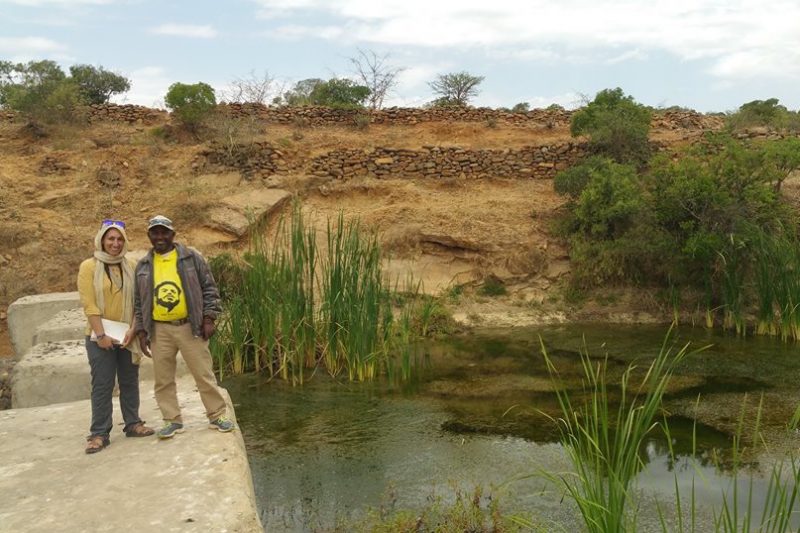Student research yields key insights on community dynamics
In Ethiopia today, local communities, governments, and international institutions are working together to meet the substantial challenges of climate change, food security, and environmental restoration. An integrated effort over the last two and a half decades is making strides in reversing landscape degradation and sustaining reliable livelihoods, while building resilience in the face of rising global temperatures and increased variability in rainfall. My research in Ethiopia aims to help document the transformation and identify key areas for improvement.
Contemporary Ethiopia retains a distinct agrarian identity; between 75-85% of the people in Ethiopia are directly dependent on agriculture and pastoralism as livelihood strategies. Accordingly, the majority of Ethiopia’s land-locked terrain is dominated by agricultural and pastoral activities. Agro-ecological resilience is therefore not only socially and economically vital; on-farm innovations and interventions to conserve soil, water, and biodiversity are also critical for climate change adaptation and mitigation. Community-Led Participatory Restoration—a partnership approach to restoration that seeks to equitably involve local stakeholders in all aspects of the restoration process—has increasingly become a key feature of rural development strategies in much of the country.
Abreha we Atsbeha, a village in Northern Ethiopia, stands as a remarkable case study in such community-led participatory restoration. The community employs a land management approach known as Integrated Watershed Management (IWM). IWM has transformed Abreha we Atsbeha’s socio-ecological landscape: Where once the mountainsides surrounding the village were completely denuded, and not even the deepest wells drew water during the dry season, today the mountainsides are densely vegetated and water flows freely, both from wells and from once-seasonal rivers that now run year-round. Where once the community relied entirely on food aid, today Abreha we Atsbeha boasts a high degree of food sovereignty. Abreha we Atsbeha was recognized by the UN World Food Programme and awarded a UN Equator Prize at the 2012 RIO+20 summit for their “outstanding projects working to advance sustainable development solutions for people, nature and resilient communities.”
IWM not only requires adjustments to on-farm practices, but also relies heavily on large-scale, labor intensive projects that improve the hydrology of surrounding hillsides. To carry out such projects, many communities in Ethiopia—in particular in the Tigray region—organize a yearly event called the Free Labour Contribution Period (FLCP). During this time, the community works together for twenty to sixty days on landscape-scale restoration projects. In Abreha we Atsbeha, over the last two decades, thousands of hectares of land have been restored during the FLCP. Despite the centrality of the FLCP to the fabric of community life and to the dynamics of landscape restoration, virtually nothing has been published exploring its origins, current manifestations, or future prospects. In order to better understand this unique system, I traveled to Abreha we Atsbeha to document the FLCP as it was taking place.
This visit was a key step in what has been a multi-year research project. I began this research in January 2017, and traveled to Ethiopia in March 2017 to assist the World Agroforestry Centre (ICRAF) in developing new partnerships and proposals, while simultaneously scoping potential research sites. After selecting Abreha we Atsbeha as a site and arranging the requisite research permissions, I spent the next year studying Amharic, conducting an extensive literature review and developing an original study design, before returning to Abreha we Atsbeha the following spring.
While in Abreha we Atsbeha, I relied on blended research methods. In addition to conducting structured and semi-structured interviews, focus groups, participant observation, and participatory mapping sessions, I also volunteered my own manual labor during the community FLCP. Each day, I walked several kilometers with the community to different project sites, where I would help excavate and carry rocks, construct stone terraces, and build small stone ‘check dams’. Doing so improved my understanding of both the biophysical and socio-cultural subtleties of large-scale, community-based participatory restoration, while also helping me build relationships and rapport with community members.
Through this research, I was able to collect key information about the FLCP and the intricacies of local political life in Abreha we Atsbeha. I am sharing the results of my fieldwork in a report to the Consultative Group for International Agriculture Research (CGIAR), which includes targeted set of recommendations for baseline data collection, program development, and monitoring and evaluation, thereby directly impacting development and sustainability strategies in the Tigray region and beyond.
I will spend the next year refining my analysis and disseminating the results across a wide audience, though publications in academic journals and blog posts, and presentations at several conferences and colloquia. Through this work, I aim to contribute to efforts in the international restoration community to build a more comprehensive understanding of the social and political dimensions of conservation and reforestation, and thereby improve prospects for scaling successful case studies like Abreha we Atsbeha.
In the spring of 2018, Emily Sigman (Master of Global Affairs, Master of Forestry ‘20) traveled to Abreha we Atsbeha, a rural village in northern Ethiopia. There, as part of her independent research project with Dr. Florencia Montagnini, she documented the critical role that local bylaws and institutions play in facilitating landscape restoration, food security, and climate change mitigation. This research was supported by the community of Abreha we Atsbeha, the National Science Foundation Graduate Research Fellowship Program, The Yale School of Forestry and Environmental Studies, The Yale Jackson Institute for Global Affairs, and the World Agroforestry Centre (ICRAF), part of the Consultative Group for International Agriculture Research (CGIAR),
